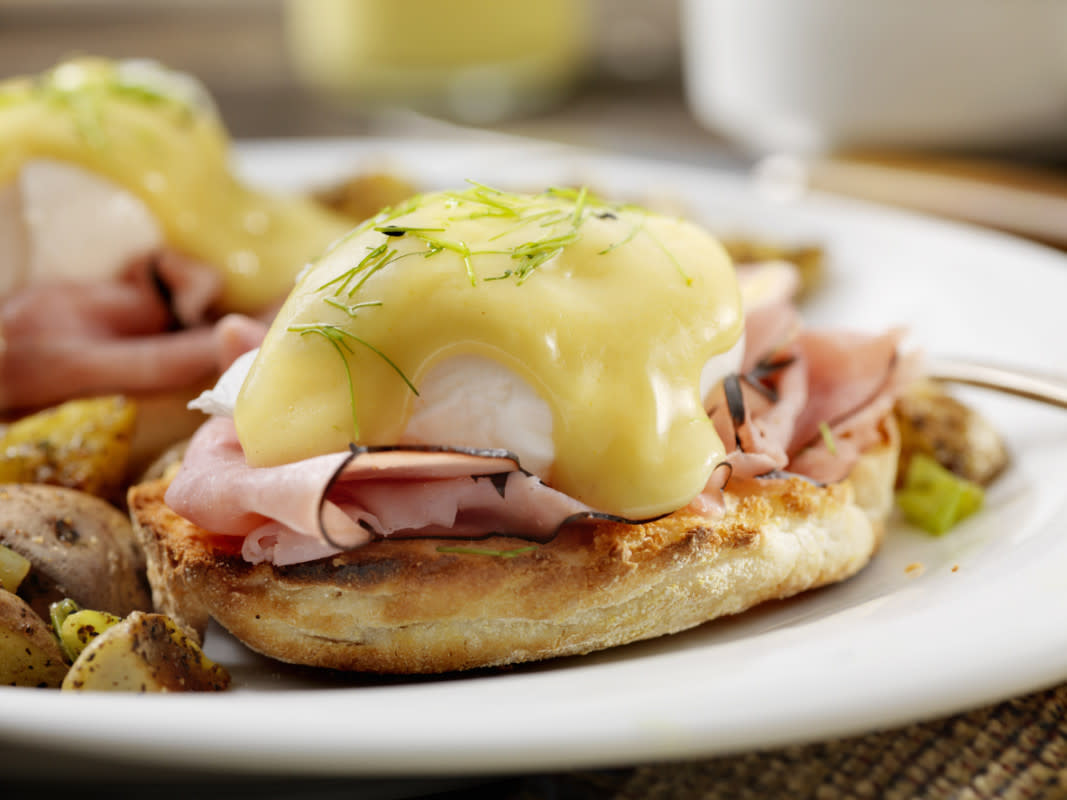How to Make the Easiest-Ever Eggs Benedict, According to Julia Child

Eggs Benedict
One of my favorite Julia Child quotes is, “With enough butter, anything is good.” I totally agree, but there are some butter-heavy recipes that are tricky and could end in disaster if not prepared correctly. Take Eggs Benedict for example. It's one of those dishes that I wish I could make more often, but the thought of making Hollandaise sauce from scratch causes me to just eat cereal instead.
If you’re not familiar, Eggs Benedict consists of a halved and lightly toasted English muffin, a slice of Canadian bacon, a poached egg and a generous pour of French Hollandaise sauce on top. The sauce is the key ingredient.
The traditional way of making Hollandaise sauce involves vigorously whisking egg yolks, butter and lemon juice over a double boiler (aka bain-marie) until the sauce thickens. Salt and cayenne pepper (or white pepper) are common seasonings. In theory, the sauce cooks up silky smooth. In reality, you can end up with curdled butter or overcooked egg yolks. And it can take up to 15 minutes to thicken!
But there's an easier and relatively foolproof way to make the sauce—a shortcut that the one and only Julia Child endorsed. Let’s welcome blender Hollandaise sauce to the party. Using a blender removes the whisking, double boiler and overall hassle. Plus, it’s a speedy option for large crowds if you’re hosting brunch. (Maybe a Mother's Day brunch this weekend?) And who doesn’t love a kitchen hack?
Related: 100 of Our Best Egg Recipes for Morning, Noon or Night
How Do You Make Blender Hollandaise Sauce?
There are several variations of blender Hollandaise sauce online. Some include whole eggs (for a fluffier result), but this simple recipe, which yields about 3/4 cup of sauce, sticks to egg yolks only. The Dijon mustard helps emulsify the sauce.
In a saucepan or in a microwaveable dish, melt 1 stick (4 ounces) of unsalted butter.
Add 4 egg yolks to a blender, 2 tablespoons of lemon juice, 1/4 teaspoon Dijon mustard and a dash of salt and cayenne pepper, if you'd like a little spice.
Cover and blend on high until slightly thickened and lemon colored.
Turn the blender to low and pour in the butter in a slow, steady stream. Crank the blender to high and process until the sauce thickens, which should take 30-40 seconds.
Taste to adjust seasonings, and you’re done. I think Julia Child would approve of this shortcut.
Hollandaise sauce should be glossy, smooth (meaning the ingredients haven’t separated) and creamy. Any unused sauce can be refrigerated in an airtight container for up to two days. When reheating, do it slowly in a saucepan and add water to thin it out, if necessary. Now that you’ve learned how to make blender Hollandaise sauce, try it on asparagus, broccoli, poached salmon or an omelet.
Up next: Here’s What Happens to Your Body if You Eat Eggs Every Day

